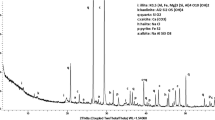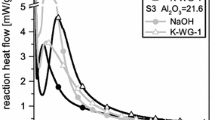Abstract
During the last few years, the valorization of marine sediment has been marked by the incorporation of this material in cementitious matrices. Some studies have depicted, more particularly, the use of the sediment in alkaline activation of Ground Granulated Blast Furnace Slag (GGBFS) for Civil Engineering applications. The objective of this work is to understand the effect of clear sediment incorporation on the reactivity of GGBFS alkali-activation. Two alkaline activators are used, a sodium hydroxide solution (NaOH) and a mixture of sodium hydroxide and sodium silicate solution (NaOH + silicate). The influence of sediment incorporation on the reactivity of Alkali-Activated GGBFS (AAS) is determined through X-ray Diffraction XRD, thermogravimetry TG and Solid State Nuclear Magnetic Resonance (NMR) analyses. Results show that the presence of sediment does not modify the structure of the hydration products formed, neither the proportion of Aluminum atoms incorporated into hydrate chains. The substitution of slag by sediment causes a delay in the initiation of alkaline activation particularly in the short term, but this effect diminishes at 28 days.









Similar content being viewed by others
References
Komnitsas K (2016) Co-valorization of marine sediments and construction & demolition wastes through alkali activation. J Environ Chem Eng 4:4661–4669. https://doi.org/10.1016/j.jece.2016.11.003
Hamer K, Karius V (2002) Brick production with dredged harbour sediments. An Ind-scale Exp Waste Manag 22:521–530. https://doi.org/10.1016/S0956-053X(01)00048-4
Dubois V, Abriak NE, Zentar R, Ballivy G (2009) The use of marine sediments as a pavement base material. Waste Manag 29:774–782. https://doi.org/10.1016/j.wasman.2008.05.004
Kamali S, Bernard F, Abriak N-E, Degrugilliers P (2008) Marine dredged sediments as new materials resource for road construction. Waste Manag 28:919–928. https://doi.org/10.1016/j.wasman.2007.03.027
Samara M, Lafhaj Z, Chapiseau C (2009) Valorization of stabilized river sediments in fired clay bricks: factory scale experiment. J Hazard Mater 163:701–710. https://doi.org/10.1016/j.jhazmat.2008.07.153
Snellings R, Cizer Ö, Horckmans L et al (2016) Properties and pozzolanic reactivity of flash calcined dredging sediments. Appl Clay Sci 129:35–39. https://doi.org/10.1016/j.clay.2016.04.019
Dalton JL, Gardner KH, Seager TP et al (2004) Properties of Portland cement made from contaminated sediments. Resour Conserv Recycl 41:227–241. https://doi.org/10.1016/j.resconrec.2003.10.003
Amar M, Benzerzour M, Safhi AEM, Abriak N-E (2018) Durability of a cementitious matrix based on treated sediments. Case Stud Constr Mater 8:258–276. https://doi.org/10.1016/j.cscm.2018.01.007
De Gisi S, Todaro F, Mesto E et al (2020) Recycling contaminated marine sediments as filling materials by pilot scale stabilization/solidification with lime, organoclay and activated carbon. J Clean Prod 269:122416. https://doi.org/10.1016/j.jclepro.2020.122416
Zentar R, Wang H, Wang D (2021) Comparative study of stabilization/solidification of dredged sediments with ordinary Portland cement and calcium sulfo-aluminate cement in the framework of valorization in road construction material. Constr Build Mater 279:122447. https://doi.org/10.1016/j.conbuildmat.2021.122447
Lim YC, Shih YJ, Tsai KC et al (2020) Recycling dredged harbor sediment to construction materials by sintering with steel slag and waste glass: characteristics, alkali-silica reactivity and metals stability. J Environ Manag 270:110869. https://doi.org/10.1016/j.jenvman.2020.110869
Wang L, Chen L, Cho DW et al (2019) Novel synergy of Si-rich minerals and reactive MgO for stabilisation/solidification of contaminated sediment. J Hazard Mater 365:695–706. https://doi.org/10.1016/j.jhazmat.2018.11.067
Ferone C, Colangelo F, Cioffi R et al (2013) Use of reservoir clay sediments as raw materials for geopolymer binders. Adv Appl Ceram 112:184–189. https://doi.org/10.1179/1743676112Y.0000000064
Peirce S, Santoro L, Andini S et al (2015) Clay sediment geopolymerization by means of alkali metal aluminate activation. RSC Adv 5:107662–107669. https://doi.org/10.1039/C5RA22140D
Ferone C, Liguori B, Capasso I et al (2015) Thermally treated clay sediments as geopolymer source material. Appl Clay Sci 107:195–204. https://doi.org/10.1016/j.clay.2015.01.027
Molino B, De Vincenzo A, Ferone C et al (2014) Recycling of clay sediments for geopolymer binder production. A new perspective for reservoir management in the framework of Italian Legislation: the occhito reservoir case study. Materials (Basel) 7:5603–5616. https://doi.org/10.3390/ma7085603
Gharzouni A, Ouamara L, Sobrados I, Rossignol S (2018) Alkali-activated materials from different aluminosilicate sources: effect of aluminum and calcium availability. J Non Cryst Solids 484:14–25. https://doi.org/10.1016/j.jnoncrysol.2018.01.014
Lirer S, Liguori B, Capasso I et al (2017) Mechanical and chemical properties of composite materials made of dredged sediments in a fly-ash based geopolymer. J Environ Manag 191:1–7. https://doi.org/10.1016/j.jenvman.2017.01.001
Xu H, Van Deventer JSJ (2002) Geopolymerisation of multiple minerals. Miner Eng 15:1131–1139. https://doi.org/10.1016/S0892-6875(02)00255-8
Xu H, Van Deventer JSJ (2000) The geopolymerisation of alumino-silicate minerals. Int J Miner Process 59:247–266. https://doi.org/10.1016/S0301-7516(99)00074-5
Wattez T, Patapy C, Frouin L et al (2020) Interactions between alkali-activated ground granulated blastfurnace slag and organic matter in soil stabilization/solidification. Transp Geotech. https://doi.org/10.1016/j.trgeo.2020.100412
Karam R, Bulteel D, Wattez T, Deneele D (2019) Effect of marine sediments incorporation on the behaviour of alkali-activated GGBFS. Mater Struct 52:110. https://doi.org/10.1617/s11527-019-1408-z
NF EN ISO 18757 (2006) Céramiques techniques - détermination de la surface spécifique (aire massique) des poudres céramiques par adsorption de gaz à l’aide de la méthode BET
NF EN 1097–7 (2008) Essais pour déterminer les caractéristiques mécaniques et physiques des granulats - Partie 7: détermination de la masse volumique absolue du filler - méthode au pycnomètre
NF P94–068 (1998) Sols: reconnaissance et essais - détermination de la valeur de bleu de méthylène d’un sol ou d’un matériau rocheux par l’essai à la tache
Wang S-D, Scrivener K, Pratt P (1994) Factors affecting the strength of alkali-activated slag. Cem Concr Res 24:1033–1043. https://doi.org/10.1016/0008-8846(94)90026-4
Myers RJ, Bernal SA, Gehman JD et al (2015) The role of Al in cross-linking of alkali-activated slag cements. J Am Ceram Soc 98:996–1004. https://doi.org/10.1111/jace.13360
Pardal X, Brunet F, Charpentier T et al (2012) 27 Al and 29 Si solid-state NMR characterization of calcium-aluminosilicate-hydrate. Inorg Chem 51:1827–1836. https://doi.org/10.1021/ic202124x
Cong X, Kirkpatrick RJ (1996) 29Si MAS NMR study of the structure of calcium silicate hydrate. Adv Cem Based Mater 3:144–156. https://doi.org/10.1016/S1065-7355(96)90046-2
Faucon P, Delagrave A, Petit JC et al (1999) Aluminum incorporation in calcium silicate hydrates (C−S−H) depending on their Ca/Si ratio. J Phys Chem B 103:7796–7802. https://doi.org/10.1021/jp990609q
Tänzer R, Buchwald A, Stephan D (2015) Effect of slag chemistry on the hydration of alkali-activated blast-furnace slag. Mater Struct 48:629–641. https://doi.org/10.1617/s11527-014-0461-x
Hunnicutt WA (2013) Characterization of calcium-silicate-hydrate and calcium-alumino-silicate-hydrate. PHD Thesis of University of Illinois at Urbana-Champaign, p.133
L’Hôpital E, Lothenbach B, Scrivener K, Kulik DA (2016) Alkali uptake in calcium alumina silicate hydrate (C-A-S-H). Cem Concr Res 85:122–136. https://doi.org/10.1016/j.cemconres.2016.03.009
Puertas F, Palacios M, Manzano H et al (2011) A model for the C-A-S-H gel formed in alkali-activated slag cements. J Eur Ceram Soc 31:2043–2056. https://doi.org/10.1016/j.jeurceramsoc.2011.04.036
Richardson I (1999) The nature of C-S-H in hardened cements. Cem Concr Res 29:1131–1147. https://doi.org/10.1016/S0008-8846(99)00168-4
Karam R (2019) Valorisation de sédiments marins non calcinés dans un liant alcali-activé à base de Laitier de Haut-Fourneau. Thèse de doctorat de Centrale Nantes, p.207
NF EN 12879 (2000) Caractérisation des boues - Détermination de la perte au feu de la matière sèche
DIA M (2013) Traitement et Valorisation de Sédiments de Dragage Phosphatés en Technique Routière. Thèse de doctorat de l’Ecole des Mines de Douai, p.169
Dubois V (2006) Etude du comportement physico-mécanique et caractérisation environnementale des sédiments marins – valorisation en technique routière. Thèse de doctorat de l’Université d’Artois, p.311
Wang D (2011) Solidification et valorisation de sédiments du port de dunkerque en travaux routiers. Thèse de doctorat de l’Ecole des Mines de Douai, p.156
Alizadeh R, Beaudoin JJ, Raki L (2011) Mechanical properties of calcium silicate hydrates. Mater Struct 44:13–28. https://doi.org/10.1617/s11527-010-9605-9
Bonaccorsi E, Merlino S, Kampf AR (2005) The crystal structure of tobermorite 14 A (Plombierite), a C-S-H phase. J Am Ceram Soc 88:505–512. https://doi.org/10.1111/j.1551-2916.2005.00116.x
Richardson IG (2008) The calcium silicate hydrates. Cem Concr Res 38:137–158. https://doi.org/10.1016/j.cemconres.2007.11.005
Qureshi MN, Ghosh S (2013) Effect of alkali content on strength and microstructure of GGBFS paste. Glob J Res Eng Civ Struct Eng 13:11–20
Ben Haha M, Le Saout G, Winnefeld F, Lothenbach B (2011) Influence of activator type on hydration kinetics, hydrate assemblage and microstructural development of alkali activated blast-furnace slags. Cem Concr Res 41:301–310. https://doi.org/10.1016/j.cemconres.2010.11.016
Walkley B, San Nicolas R, Sani M-A et al (2016) Phase evolution of C-(N)-A-S-H/N-A-S-H gel blends investigated via alkali-activation of synthetic calcium aluminosilicate precursors. Cem Concr Res 89:120–135. https://doi.org/10.1016/j.cemconres.2016.08.010
Ben Haha M, Lothenbach B, Le Saout G, Winnefeld F (2012) Influence of slag chemistry on the hydration of alkali-activated blast-furnace slag — Part II: Effect of Al2O3. Cem Concr Res 42:74–83. https://doi.org/10.1016/j.cemconres.2011.08.005
Brough A, Atkinson A (2002) Sodium silicate-based, alkali-activated slag mortars. Cem Concr Res 32:865–879. https://doi.org/10.1016/S0008-8846(02)00717-2
Cherki El Idrissi A, Paris M, Rozière E et al (2018) Alkali-activated grouts with incorporated fly ash: from NMR analysis to mechanical properties. Mater Today Commun 14:225–232. https://doi.org/10.1016/j.mtcomm.2018.01.012
Schilling PJ, Butler LG, Roy A, Eaton HC (1994) 29Si and 27Al MAS-NMR of NaOH-activated blast-furnace slag. J Am Ceram Soc 77:2363–2368. https://doi.org/10.1111/j.1151-2916.1994.tb04606.x
Kinsey RA, Kirkpatrick RJ, Hower J et al (1985) High resolution aluminum-27 and silicon-29 nuclear magnetic resonance spectroscopic study of layer silicates, including clay minerals. Am Mineral 70:537–548
Marsh A, Heath A, Patureau P et al (2018) Alkali activation behaviour of un-calcined montmorillonite and illite clay minerals. Appl Clay Sci 166:250–261. https://doi.org/10.1016/j.clay.2018.09.011
Walkley B, Provis JL (2019) Solid-state nuclear magnetic resonance spectroscopy of cements. Mater Today Adv 1:100007. https://doi.org/10.1016/j.mtadv.2019.100007
Phillips B, Kirkpatrick RJ, Hovis G (1988) 27Al, 29Si, and 23Na MAS NMR study of an Al, Si ordered alkali feldspar solid solution series. Phys Chem Miner 16:262–275. https://doi.org/10.1007/BF00220694
Fernández-Jiménez A, Puertas F, Sobrados I, Sanz J (2003) Structure of calcium silicate hydrates formed in alkaline-activated slag: influence of the type of alkaline activator. J Am Ceram Soc 86:1389–1394. https://doi.org/10.1111/j.1151-2916.2003.tb03481.x
He Y, Lu L, Struble LJ et al (2014) Effect of calcium–silicon ratio on microstructure and nanostructure of calcium silicate hydrate synthesized by reaction of fumed silica and calcium oxide at room temperature. Mater Struct 47:311–322. https://doi.org/10.1617/s11527-013-0062-0
Criado M, Fernández-Jiménez A, de la Torre AG et al (2007) An XRD study of the effect of the SiO2/Na2O ratio on the alkali activation of fly ash. Cem Concr Res 37:671–679. https://doi.org/10.1016/j.cemconres.2007.01.013
Andersen MD, Jakobsen HJ, Jø S (2003) Incorporation of aluminum in the calcium silicate hydrate (C−S−H) of hydrated portland cements: a high-field 27 Al and 29 Si MAS NMR investigation. Inorg Chem 42:2280–2287. https://doi.org/10.1021/ic020607b
Sun GK, Young JF, Kirkpatrick RJ (2006) The role of Al in C-S-H: NMR, XRD, and compositional results for precipitated samples. Cem Concr Res 36:18–29. https://doi.org/10.1016/j.cemconres.2005.03.002
Chen W, Brouwers HJH (2007) The hydration of slag, part 1: reaction models for alkali-activated slag. J Mater Sci 42:428–443. https://doi.org/10.1007/s10853-006-0873-2
Wang S-D, Scrivener KL (2003) 29Si and 27Al NMR study of alkali-activated slag. Cem Concr Res 33:769–774. https://doi.org/10.1016/S0008-8846(02)01044-X
Bonk F, Schneider J, Cincotto MA, Panepucci H (2003) Characterization by multinuclear high-resolution NMR of hydration products in activated blast-furnace slag pastes. J Am Ceram Soc 86:1712–1719. https://doi.org/10.1111/j.1151-2916.2003.tb03545.x
Acknowledgements
The authors gratefully acknowledge the supply of GGBFS from Ecocem, and their financial support through this project.
Author information
Authors and Affiliations
Corresponding author
Additional information
Publisher's Note
Springer Nature remains neutral with regard to jurisdictional claims in published maps and institutional affiliations.
Rights and permissions
About this article
Cite this article
Karam, R., Paris, M., Deneele, D. et al. Effect of sediment incorporation on the reactivity of alkali-activated GGBFS systems. Mater Struct 54, 118 (2021). https://doi.org/10.1617/s11527-021-01720-y
Received:
Accepted:
Published:
DOI: https://doi.org/10.1617/s11527-021-01720-y




